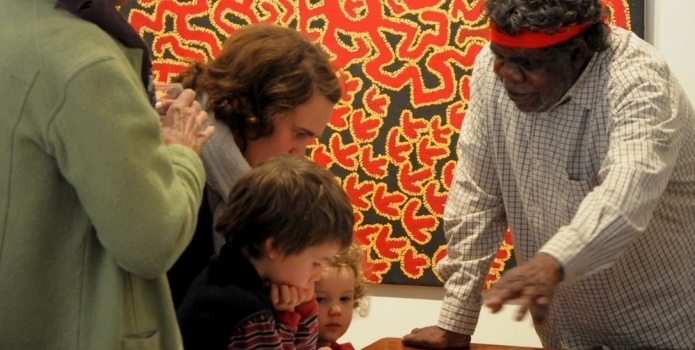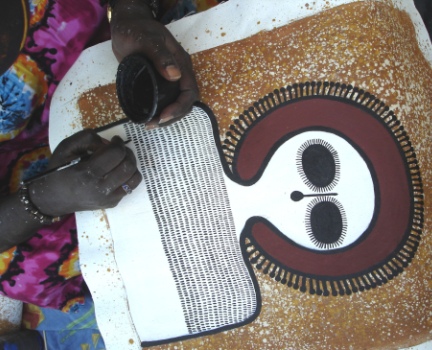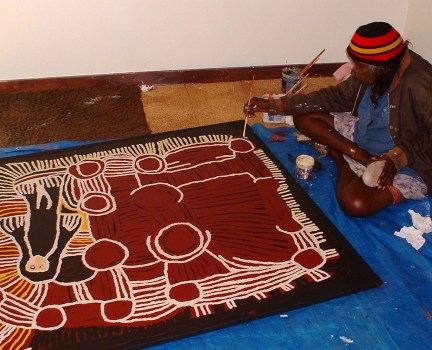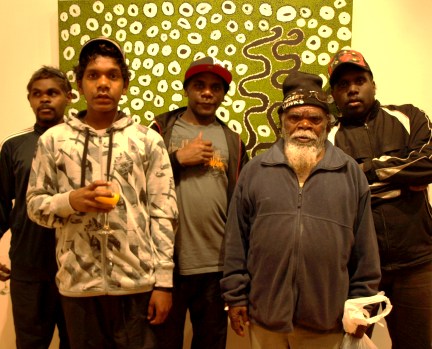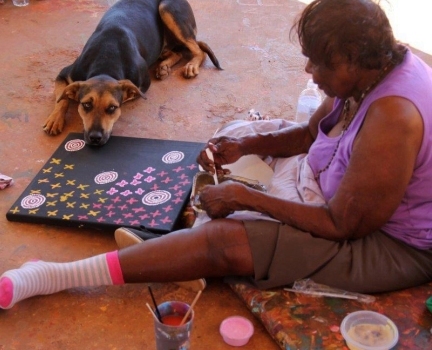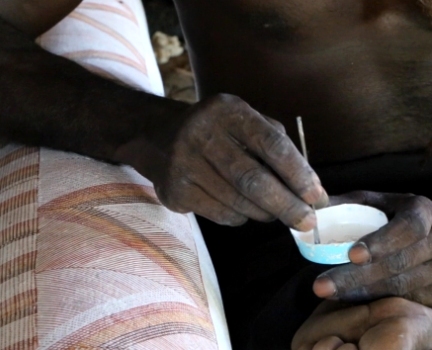An Introductory Guide to Understanding Aboriginal Art
Australian Aboriginal art is a unique view into the culture and values of Aboriginal people. Its expansion to reach a much wider audience has allowed a greater awareness of the nature of traditional Aboriginal world. There are many aspects to gaining a greater understanding of Aboriginal art, including looking widely at good examples of art from the many regions of Australia.
Japingka Gallery has curated and presented over 175 exhibitions of Aboriginal art, and continually works at providing quality information and background to all its exhibitions and artists.
In this introductory guide we have summarised some of the features of Aboriginal art to aid in the understanding contemporary Aboriginal art more broadly.
1) Australian Aboriginal art is regional in style, it gets its form and content from the local Aboriginal culture which is distinctive from one area to the next.
2) Aboriginal art is based on stories and knowledge that is being passed down through the generations – it is a way to communicate meaning and ideas about important cultural and spiritual beliefs.
3) The stories behind the Aboriginal art works are connected to individuals through family lineages, as groups become custodians for particular parts of cultural events and stories.
4) Aboriginal art works are often produced communally, as artists work together on their individual paintings, and this reinforces social and cultural values. Group cohesion and interdependence is further supported by the production of paintings.
5) Some Aboriginal art works are produced collaboratively, with a group of artists sharing in telling one story on one painting, usually where all members of the group have an association with the story or map of country being depicted.
6) Traditional Aboriginal art requires authority, knowledge, association and recognition by the artist who produces the painting. Artists are only permitted to paint the stories and subjects that they are entitled to under traditional law.
7) Aboriginal art has different levels of interpretation, with the greater knowledge belonging to elders of the Aboriginal group, who understand the stories in detail. Therefore it is possible for outsiders to understand some aspects of the stories, while more sacred sections may be with- held from descriptions or paintings.
8) Many of the cultural stories relate to traditional practices around bush survival – management of resources and land, water and bush tucker. This is knowledge that is passed down over generations and has been critical for survival for Aboriginal people.
9) Aboriginal art practice has thrived in recent decades, and the process of re-telling stories and painting the images has reinforced the values associated with traditional life in the bush.
10) Art is well established as a business enterprise for Aboriginal families, particularly in Central and northern Australia. Art skills are passed on in traditional ways, by watching and learning, then by assisting and contributing to other family members, and finally by developing a personal artistic role.
11) Few traditional Aboriginal artists sign their canvases on the front of the painting – the content of the painting is in many ways the artistic signature of the artist, as it is restricted to just a few authorised individuals to paint.
12) Colour in Aboriginal art is not strictly mandated – it does not universally represent a particular meaning or association, and varies between artists and regions. While earth colours are seen as ‘traditional’ all colours available to artists have been embraced and much has depended on availability of colours.
13) Estimates of the number of Aboriginal artists working in Australia have put the figure at over 5,000 artists, spread over all parts of the nation.
14) Many Aboriginal artists value recognition within their own groups as highly as recognition from external sources, though often travel and success from art events becomes part of the artist’s identity with the group.
15) The body of Aboriginal art work produced since 1971 when the Desert Art movement began in Papunya, has been impressive. It has also been in transition, with stylistic changes in scale, colour, materials and execution that leave a clear path of evolution in contemporary Aboriginal art.
16) The first and second generations of Aboriginal artists were born in the bush and lived close to a traditional nomadic lifestyle. More Aboriginal artists today are born in communities and towns and share both traditional Aboriginal and modern Western values.
17) Contemporary Aboriginal art will reflect an important time in Australia, recording values, marking changes, and reinforcing culture and identity in Aboriginal groups.
18) Exhibitions around the world have established the unique qualities of Aboriginal art, as a striking confluence of ancient values, modern materials and an abundant wellspring of visual language and symbols.
19) Specialist contemporary Aboriginal art galleries have become the venues to view Aboriginal art, moving away from the emphasis on ethnographic presentation, as would have been the case in museums in the past. Aboriginal art is also shown in the context of modern contemporary world art.
20) The immediate future continues to look positive for Aboriginal art, though small remote communities that have contributed to its expansion continue to deal with difficult social issues and skills issues related to modernity and the environment.
21) The specialised secondary market in Australian Aboriginal art has been established for about 20 years in Australian auction houses. The Aboriginal art market is still in its early stages of development, and will mature with time and as more work in research and documentation is added to the existing body of work.
Read more:

